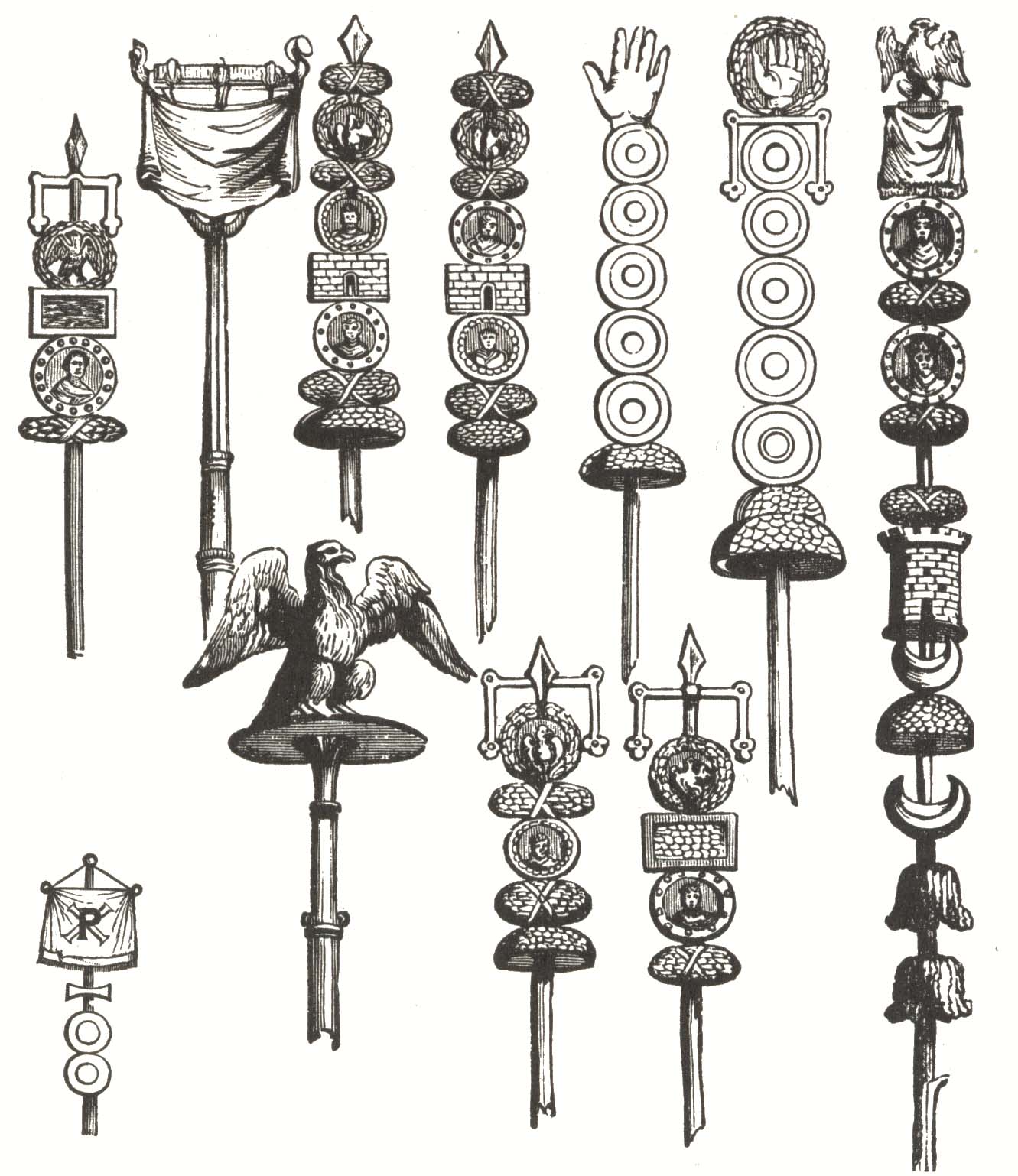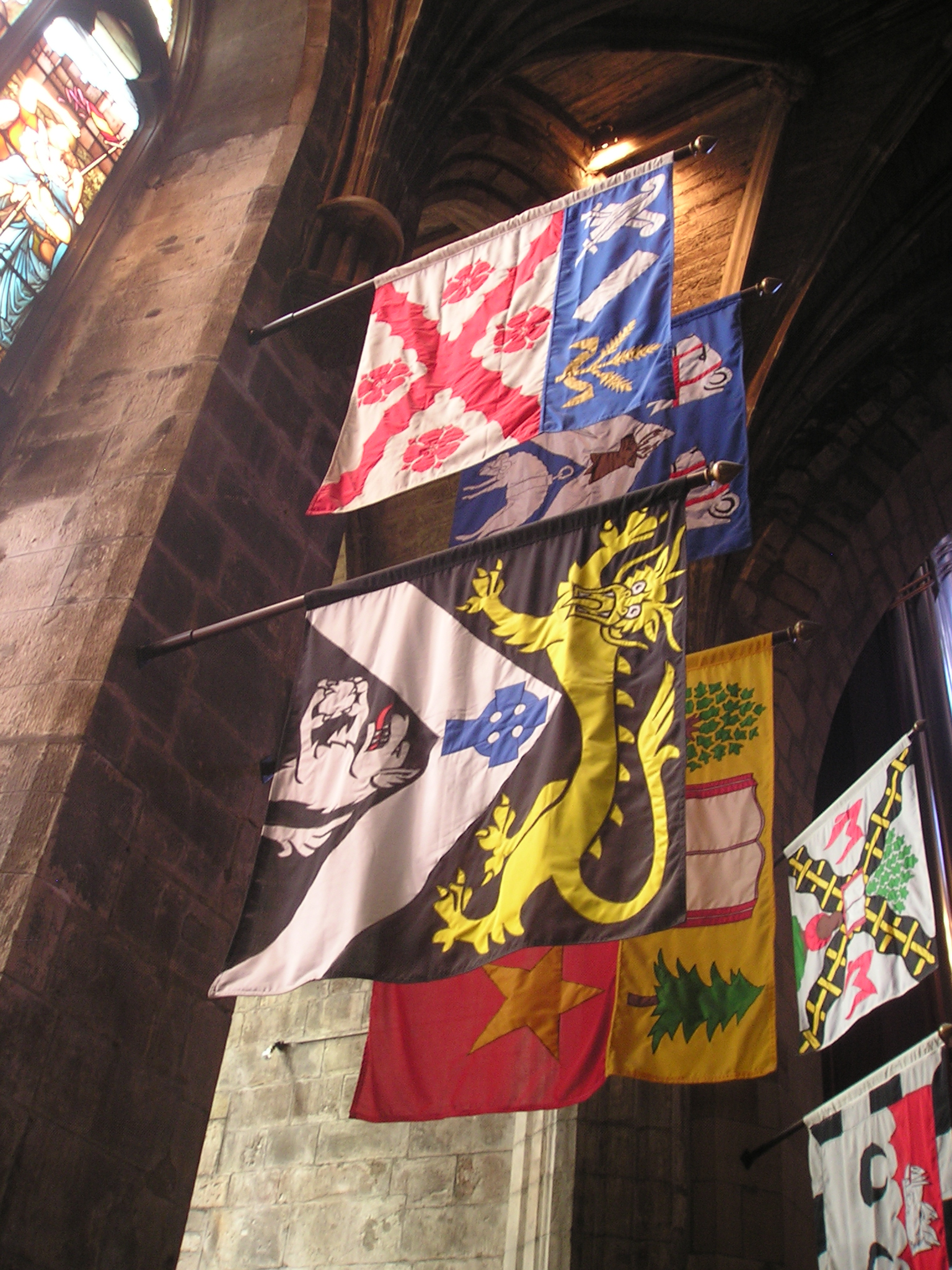|
Vexilla
The ''vexillum'' (; : ''vexilla'') was a flag-like object used as a military standard by units in the Roman army. A common ''vexillum'' displayed imagery of the Roman ''aquila'' on a reddish backdrop. Use in Roman army The word ''vexillum'' is a derivative of the Latin word, ''velum'', meaning a sail, which confirms the historical evidence (from coins and sculpture) that ''vexilla'' were literally "little sails": flag-like standards. In the ''vexillum'', the cloth was draped from a horizontal crossbar suspended from a staff. That is unlike most modern flags in which the "hoist" of the cloth is attached directly to a vertical staff. The bearer of a ''vexillum'' was known as a ''vexillarius'' or ''vexillifer''.Vexillum ''Flagspot.net'', retrieved March 18, 2011 Just as in the case of the |
Vexilla Regis
''Vexilla regis prodeunt'' (; often known in English translation as The Royal Banner Forward Goes) is a Latin hymn in long metre by the Christian poetry, Christian poet and saint Venantius Fortunatus, Bishop of Poitiers. It takes its title from its incipit. In modern English usage, it is sung to a variety of tunes, although the original plainsong melody is the most common variant. History The hymn was first sung for the Processional hymn, procession (on November 19, AD 569) of a relic of the True Cross, that was sent by Byzantine Emperor Justin II from the East at the request of St. Radegunda, and was carried in great pomp from Tours to her monastery of Saint-Croix at Poitiers. Its original processional use is commemorated in the Roman Missal on Good Friday, when the Eucharist, Blessed Sacrament is carried in procession from the Repository to the High Altar. Its principal use is in the Divine Office, with the Roman Breviary assigning it to Vespers from the Saturday before Pas ... [...More Info...] [...Related Items...] OR: [Wikipedia] [Google] [Baidu] [Amazon] |
Vexillarius
left, A reenactor, equipped as a ''vexillifer'', with a ''vexillum'' standard Vexillarius is a term referring to one of several distinct types of Roman soldier. A vexillarius or vexillifer was one of the '' signiferi'' in a Roman legion. His duty was to carry the ''vexillum'', a military standard displaying the name and emblem of the legion. This standard consisted of a woven fabric banner, hung on a crossbar attached to a pole or lance. It was used by both infantry and cavalry. It could designate a vexillation (Latin: ''vexillatio''), a detachment from a larger unit, though it was most likely also a standard for regular complete or component units (such as legions, cohorts, ''alae''). The term vexillarius may also refer to specially re-enlisted veterans. These soldiers were so named because they served in a company (''vexillatio'') under their own ''vexillum'' standard within the legion, separate from the ordinary legionaries in the cohorts of that same legion. They had privileg ... [...More Info...] [...Related Items...] OR: [Wikipedia] [Google] [Baidu] [Amazon] |
Vexillatio
A ''vexillatio'' (: ''vexillationes'') was a detachment of a Roman legion formed as a temporary task force created by the Roman army of the Principate. It was named from the standard carried by legionary detachments, the ''vexillum'' (: ''vexilla''), which bore the emblem and name of the parent legion. Although commonly associated with legions, it is likely that ''vexillationes'' included auxiliaries. The term is found in the singular, referring to a single detachment, but is usually used in the plural to refer to an army made up of picked detachments. ''Vexillationes'' were assembled ''ad hoc'' to meet a crisis on Rome's extensive frontiers, to fight in a civil war, or to undertake an offensive against Rome's neighbours. They varied in size and composition, but usually consisted of about 1000 infantry and/or 500 cavalry Historically, cavalry (from the French word ''cavalerie'', itself derived from ''cheval'' meaning "horse") are groups of soldiers or warriors who Horses i ... [...More Info...] [...Related Items...] OR: [Wikipedia] [Google] [Baidu] [Amazon] |
Costellariidae
Costellariidae sometimes called the "ribbed miters" is a Taxonomy (biology), taxonomic family (biology), family of minute to medium-sized predatory sea snails, marine (ocean), marine gastropod mollusks. This family of snails is also sometimes referred to as ''Vexillum'' miters. The main family of miter shells however is Mitridae, a closely related group. The monophyly of this family has been confirmed. Taxonomy This family was previously sometimes known as Vexillidae. ''Latiromitra'' (from family Ptychatractidae) has been found to be closely related to Costellariidae in the molecular phylogeny analysis by Fedosov & Kantor (2010). Description The shell ranges from small to medium-sized, with an elongate shape that is typically fusiform, elongate-fusiform, or turriform. The protoconch is glossy and smooth, usually multispiral and narrowly conical, though it can sometimes be paucispiral and bulbous. The shell often features a high Spire (mollusc), spire, a very narrow Aperture ... [...More Info...] [...Related Items...] OR: [Wikipedia] [Google] [Baidu] [Amazon] |
Icon
An icon () is a religious work of art, most commonly a painting, in the cultures of the Eastern Orthodox, Oriental Orthodox, Catholic Church, Catholic, and Lutheranism, Lutheran churches. The most common subjects include Jesus, Mary, mother of Jesus, Mary, saints, and angels. Although especially associated with portrait-style images concentrating on one or two main figures, the term also covers most of the religious images in a variety of artistic media produced by Eastern Christianity, including narrative scenes, usually from the Bible or the lives of saints. Icons are most commonly painted on wood panels with egg tempera, but they may also be cast in metal or carved in stone or embroidered on cloth or done in mosaic or fresco work or printed on paper or metal, etc. Comparable images from Western Christianity may be classified as "icons", although "iconic" may also be used to describe the static style of a devotional image. In the Greek language, the term for icon painting uses ... [...More Info...] [...Related Items...] OR: [Wikipedia] [Google] [Baidu] [Amazon] |
Vexilloid
A vexilloid is any flag-like (vexillary) object used by countries, organisations, or individuals as a form of representation other than flags. American vexillologist Whitney Smith coined the term ''vexilloid'' in 1958, defining it as This includes vexillum, vexilla, banderoles, pennons, streamers, heraldic flag, heraldic flags, standards, and gonfalons. Examples include the Sassanid battle standard Derafsh Kaviani, and the standards of the Roman legion, Roman legions such as the Aquila (Roman), eagle of Augustus Caesar's Legio X Fretensis, Xth legion and the Draconarius, dragon standard of the Sarmatians; the latter was allowed to fly freely in the wind, carried by a horseman, but depictions suggest that it bore more similarity to an elongated dragon kite than to a simple flag. The use of flags replaced the use of vexilloids for general purposes during late medieval times between about 1100 to about 1400. However, vexilloids still remain in use for specialised purposes, such as ... [...More Info...] [...Related Items...] OR: [Wikipedia] [Google] [Baidu] [Amazon] |
Banner
A banner can be a flag or another piece of cloth bearing a symbol, logo, slogan or another message. A flag whose design is the same as the shield in a coat of arms (but usually in a square or rectangular shape) is called a banner of arms. Also, a bar-shaped piece of non-cloth advertising material sporting a name, slogan, or other marketing message is also a banner. Banner-making is an ancient craft. Church banners commonly portray the saint to whom the church is dedicated. The word derives from Old French ''baniere'' (modern ), from Late Latin ''bandum'', which was borrowed from a Germanic languages, Germanic source (compare ). Cognates include Italian language, Italian ''bandiera'', Portuguese language, Portuguese ''bandeira'', and Spanish language, Spanish ''bandera''. Vexillum The vexillum was a flag-like object used as a military standard by units in the Ancient Roman army. The word ''vexillum'' itself is a diminutive of the Latin ''velum'', meaning a sail, which confir ... [...More Info...] [...Related Items...] OR: [Wikipedia] [Google] [Baidu] [Amazon] |
Gonfalon
The gonfalon, gonfanon, gonfalone (from the early Italian ''confalone'') is a type of heraldic flag or banner, often pointed, swallow-tailed, or with several streamers, and suspended from a crossbar in an identical manner to the ancient Roman vexillum. It was first adopted by Italian medieval communes, and later, by local guilds, corporations and districts. The difference between a gonfalon with long tails and a standard is that a gonfalon displays the device on the non-tailed area, and the standard displays badges down the whole length of the flag. Background A gonfalon can include a badge or coat of arms, or decoration. Today, every Italian comune (municipality) has a gonfalon sporting its coat of arms. The gonfalon has long been used for ecclesiastical ceremonies and processions. The papal " ombrellino", a symbol of the pope, is often mistakenly called "gonfalone" by the Italians because the pope's ceremonial umbrella was often depicted on the banner. Gonfalons are also used ... [...More Info...] [...Related Items...] OR: [Wikipedia] [Google] [Baidu] [Amazon] |
Legion Of Mary
The Legion of Mary (, post-nominal letters, postnominal abbreviation L.O.M.) is an international association of members of the Catholic Church who serve on a Voluntary association, voluntary basis. It was founded in Dublin, as a Roman Catholic Marian Movement, Marian movement by the layman and civil servant Frank Duff. Today, active and auxiliary (praying) members make up a total of over 10 million members worldwide, making it the largest Consecrated life (Catholic Church)#Apostolic congregations, apostolic organization of Catholic laity, laypeople in the Catholic Church. Membership is highest in South Korea, Philippines, Brazil, Argentina and the Democratic Republic of Congo, which each have between 250,000 and 500,000 members. Membership is open to believing members of the Catholic Church. Its stated mission is for active members to serve God under the banner of Mary, mother of Jesus, Mary through the works of mercy, corporal and spiritual works of Mercy, as mentioned in Cha ... [...More Info...] [...Related Items...] OR: [Wikipedia] [Google] [Baidu] [Amazon] |
Chi-Rho
The Chi Rho (☧, English pronunciation ; also known as ''chrismon'') is one of the earliest forms of the Christogram, formed by superimposing the first two (capital) letters—chi (letter), chi and rho (ΧΡ)—of the Greek (Romanization of Greek, rom: Christ (title), Christos) in such a way that the vertical stroke of the rho intersects the center of the chi. The Chi-Rho symbol was used by the Roman Emperors, Roman Emperor Constantine the Great (r. 306–337 AD) as part of a military standard (vexillum). Constantine's standard was known as the Labarum. Early symbols similar to the Chi Rho were the Staurogram () and the IX monogram (). Although formed of Greek characters, the device (or its separate parts) is frequently found serving as an abbreviation in Latin text, with endings added appropriate to a Latin noun, thus ''XPo'', signifying ''Christo'', "to Christ", the dative form of ''Christus'', or ', signifying ''Christicola'', "Christian", in the Latin lyrics of ''Sumer ... [...More Info...] [...Related Items...] OR: [Wikipedia] [Google] [Baidu] [Amazon] |
Constantine I
Constantine I (27 February 27222 May 337), also known as Constantine the Great, was a Roman emperor from AD 306 to 337 and the first Roman emperor to convert to Christianity. He played a Constantine the Great and Christianity, pivotal role in elevating the status of Christianity in Rome, Edict of Milan, decriminalising Christian practice and ceasing Persecution of Christians in the Roman Empire, Christian persecution. This was a turning point in the Historiography of the Christianization of the Roman Empire, Christianisation of the Roman Empire. He founded the city of Constantinople (modern-day Istanbul) and made it the capital of the Empire, which it remained for over a millennium. Born in Naissus, a city located in the Roman province, province of Moesia Superior (now Niš, Serbia), Constantine was the son of Flavius Constantius, a Roman army officer from Moesia Superior, who would become one of the four emperors of the Tetrarchy. His mother, Helena, mother of Constantin ... [...More Info...] [...Related Items...] OR: [Wikipedia] [Google] [Baidu] [Amazon] |






